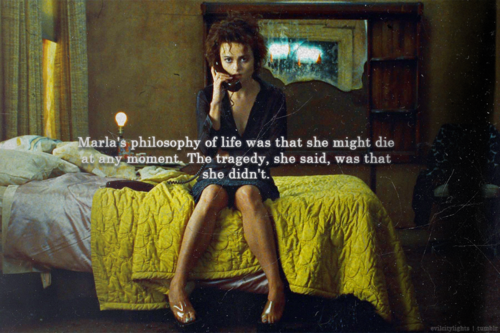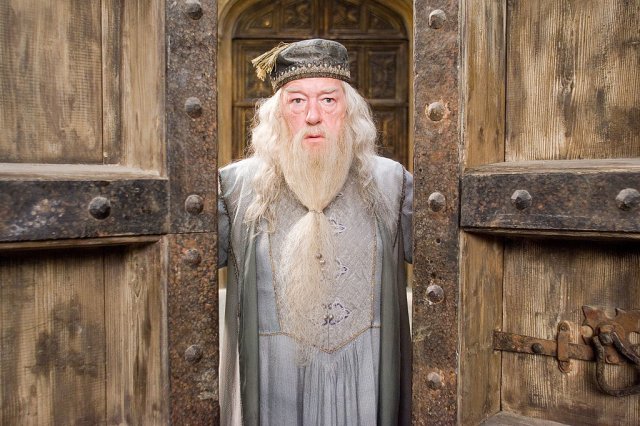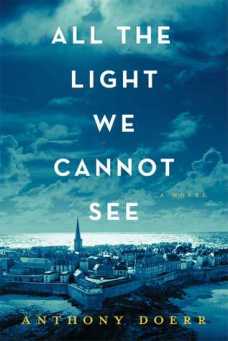10. Chigurh – No Country For Old Men

Seriously, this is the creepy evil dude you NEVER want to look up and see staring back at you out your window. Cormack McCarthy’s archetypal villain comes in at number 10, but he is only the first of several bad boys to make the list. In No Country for Old Men’s southern gothic story, this psychopathic killer keeps your heart pounding as he hunts down the main character and the money he came into possession of. Chigurh is best known for flipping a coin to decide the fate of his victims, so if a dude ever comes up to you doing this and starts spitting mad philosophy, get the heck out of there. And definitely don’t call him Sugar.
People always say the same thing.
They say, “You don’t have to do this.”
This is the best I can do. Call it.
I got here the same way the coin did.
.
.
.
9. Marla Singer – Fight Club
If you haven’t met Marla Singer yet, you clearly haven’t been attending your local testicular cancer victims support group. This is where Marla meets the main character of the novel, where her life goes from fucked up to a deranged love triangle with a man and his multiple personalities (studies have found that this is a bit more fucked up). However weird, Marla is more than just a cigarette-smoking machine with the occasional comedic relief, she is one of the few consistencies in the life of the main character’s twisted story.
Interesting fact: Marla’s character was named after a childhood bully to the author, Chuck Palahniuk. Got em’.
8. Robert Langdon – Angels & Demons, The Davinci Code
Harvard University’s symbology and religious iconography teacher (sounds like something I don’t recommend majoring in) joins us at number 8 on the list as he goes from geeky professor to treasure hunting badass in Dan Brown’s best selling novels. There are 4 books currently featuring the professor, but these 2 are the best known thanks to film adaptations, and just being plain fucking awesome. Always rocking his Harris Tweed jacket and Mickie Mouse watch (yes, this is why I wear one), Robert Langdon follows clues that lead to history’s greatest mythical treasures, that offer both thrills and surprisingly a great deal to learn about religious and archeological history.
7. Zero – Holes
In the world of literature there is a character known as the “deuteragonist”- which means you experience agony while doing your duty. ACTUALLY THOUGH it means second in order of importance to the protagonist. Holes is the story of Stanley Yelnats and his untimely detention in Camp Greenlake, where kids are made to dig holes in the desert all day long as punishment. I say screw the duty-whatever, Hector Zeroni, AKA Zero, steals this shit out of this book. Stanley finds out that Zero is the key to breaking his family’s age old curse, and we find out Zero is the key to learning the meaning of friendship and humility at a young age.
.
Sploosh and Chill?
6. Charlie – The Perks of Being a Wallflower
I think the obvious perk of being a wallflower is getting with Emma Watson in the movie adaptation, but that’s just me.Whether or not you consider yourself one of the millions of people who love The Perks of Being a Wallflower is contingent primarily on one thing: whether or not you ever considered yourself a “wallflower” in school, with a girl, in life. Charlie is one; someone who tries to blend in to the crowd, someone you don’t notice right away. They are silent but they see things for what they are. Charlie’s first person narrative is both insightful and poignant, and basically has his own subsection on Tumblr for all his quotes and awkward smiles that girls go batshit for. For that, Charlie gets number 6 on the list.
.
So, this is my life. And I want you to know that I am both happy and sad and I’m still trying to figure out how that could be.
5. Don Tillman – The Rosie Project
Ever wondered what it would be like to have Asperger’s syndrome and searching for the perfect wife? Well, me neither really, but this is what we’ve got.
Don Tillman is a quirky, highly intelligent college professor who is searching for a life partner, by setting up a complex surveying process that makes you wish he would just give Tinder a try. Finally a girl named Rosie comes into the picture and Don learns that there is more to love than just brain chemicals and shit. Don’s social ineptitude mixed with the unfolding of an unlikely romance makes him one of the most hilarious and unique characters I have ever met/read about.
.
But I’m not good at understanding what other people want.’
‘Tell me something I don’t know,’ said Rosie for no obvious reason.
I quickly searched my mind for an interesting fact.
‘Ahhh…The testicles of drone bees and wasp spiders explode during sex.
4. Jaime Lannister – A Game of Thrones
There’s something really cool about watching an incestuous ass-hat develop into a good hearted, truly inspiring individual. I wish it happened more often, but maybe thats a bit niche. Regardless, this is Jaime Lannister, whose story meets a serious turning point in the second book when he is taken captive by the Starks. Westeros’ golden boy goes on both a physical and personal journey when he joins up with Brienne of Tarth, losing a hand, but gaining a beard and so much more. Jamie becomes a hero with a past filled with sins he is constantly being forced to pay for, yet someone we can’t help but cheer on. And hope George RR Martin doesn’t kill him. George pls.
.
‘I WISH I COULD JUST FIX U’ – adoring fangirl, book 1
‘ok fine’ – Jaime Lannister, book 2
3. Inquisitor Glokta, The Blade Itself
WHO THE F***??? You’re probably wondering why a person you have never heard of is in my top 3. Hey. Hear me out. If you’re a fan of the Game of Thrones series for the story, and not just Jaime’s rugged good looks, you might definitely like this trilogy, which begins with The Blade Itself.
Several years before the events that take place in The Blade Itself, Glokta was the toast of the kingdom- handsome, champion swordsman; not all that unlike Jaime. And then he went to war and got captured. And tortured. A lot. Fast forward to the present and he is now a torturer himself in the King’s inquisition. Missing limbs and alternating teeth, Glokta is the filet mignon of bitter, self-pitying assholes with just a slight seasoning of humanity that you can’t help but love.
.
Every man has his excuses, and the more vile the man becomes, the more touching the story has to be. What is my story now, I wonder?
2. Professor Dumbledore, Harry Potter
I have this fantasy that someday I’ll be sitting in an interview with my future Boss, and, after complimenting me on my dashing tie, he/she will lean in and ask me, ‘Who is your hero?’. I will reply with Albus Dumbledore, and they will proceed to fist bump me and say, ‘Damn son. Say no more’. The job will be mine.
This man truly needs no introduction. We all grew up reading the Harry Potter series, harassing the mailman, wondering where the hell our letter to Hogwarts went. All to meet this guy. Unlike all the other characters on this list, Dumbledore doesn’t stand out for just his own personal greatness, he stands out for the greatness that he is able to bring out in others. He believes there is good in all of us- whether you are Neville Longbottom, Harry Potter, or even Tom Riddle, this man was willing to help you.
Professor Dumbledore is more than just my literary hero, he was my mentor growing up.
.
Remember, if the time should come when you have to make a choice between what is right, and what is easy, remember what happened to a boy who was good and kind and brave because he strayed across the path of Lord Voldemort.
1. Lisbeth Salander, The Girl with the Dragon Tattoo
I can only imagine that Prof. Dumbledore might be a little salty that the only literary character to place above him on this top 10 list would likely be placed in the Slytherin house. Just look at those neck spikes. You think any Gryffindor girl fucks with that?

Anyone who really knows me knows that I worship the bookshelf that this novel walks on. I named my first dragon Tattoo. Many of my closest friends have dealt with the terrifying experience of me holding this book to their neck and demanding that they read it. This is of course, The Girl with the Dragon Tattoo trilogy, which is a crime/mystery thriller following the current events and troubled past of Lisbeth Salander, who- believe it or not, has a tattoo of a dragon.
If you’ve ever called someone an “extreme feminist”, you don’t know what that term means until you’ve met this chick. Lisbeth is the quintessential modern female badass, whose uses her anger and extraordinary intelligence t0 extract revenge on the numerous men that have wronged her. In fact, this novel’s original title was “Men who hate Women”, which I can only assume was changed so that guys would buy this book too. Throughout this mind-blowing trilogy, the novels delve into Lisbeth’s past; revealing a depth of character unlike anything else within girl that lives by her own rules and fights (rather violently) for what she believes is right. If Lisbeth Salander didn’t take #1 on my list favorite literary characters because I said so, she would probably just take it by force.
 I thought Ginny was lying about that Hungarian Horntail tattoo.
I thought Ginny was lying about that Hungarian Horntail tattoo..
.
.
.
.
.
Thanks for reading! Honorable mentions that did not make the list:
- Holden Caulfield, The Catcher in the Rye
- Marie Laure, All the Light We Cannot See
- Sevro, Red Rising










 I thought Ginny was lying about that Hungarian Horntail tattoo.
I thought Ginny was lying about that Hungarian Horntail tattoo.
 In the Mus
In the Mus



 Also known as There and Back Again, this timeless adventure story was published in 1937, and originally written for Tolkien’s very own children. Nearly a century in the future, and that is exactly how it still sounds. Throw together a hero who is destined to make peace between good and evil with the most gentle, light-hearted narrator you will ever hear (seriously, imagine Morgan Freeman is reading this to you, thank me later) and you have the perfect bedtime story for any age. There is one of many observations in this book, where Tolkien muses that a story of a good time is often too quickly told, but a story of an evil time requires a great many words to recount the events thereof. This observation almost perfectly accounts for the difference between The Hobbit and The Lord of The Rings, which would become one of the most epic trilogies of all time. This book is famous for more than just its incredible ability to take us on an adventure, but because it is the prologue for so much more.
Also known as There and Back Again, this timeless adventure story was published in 1937, and originally written for Tolkien’s very own children. Nearly a century in the future, and that is exactly how it still sounds. Throw together a hero who is destined to make peace between good and evil with the most gentle, light-hearted narrator you will ever hear (seriously, imagine Morgan Freeman is reading this to you, thank me later) and you have the perfect bedtime story for any age. There is one of many observations in this book, where Tolkien muses that a story of a good time is often too quickly told, but a story of an evil time requires a great many words to recount the events thereof. This observation almost perfectly accounts for the difference between The Hobbit and The Lord of The Rings, which would become one of the most epic trilogies of all time. This book is famous for more than just its incredible ability to take us on an adventure, but because it is the prologue for so much more. Bilbo is living peacefully in his home at Bag End in Hobbiton when one day his small world is turned upside down by the arrival of Gandalf, a well-respected wizard who is widely known for always having his nose in an adventure, and a killer fireworks show. Gandalf arrives uninvited in Bilbo’s home along with 13 dwarves, who have chosen Bilbo to come on an adventure with them. Gandalf and the dwarves explain that they are on a quest to travel across Middle Earth to reclaim an ancient treasure from a giant, marauding dragon by the name of Smaug. On this episode of Hoarders, we visit the home of Smaug, a giant cavern under a mountain filled with treasure a dragon couldn’t possibly have any use for. Unfortunately for the band of travelers, Bilbo thinks the only good that can come of an adventure is making him late to dinner.
Bilbo is living peacefully in his home at Bag End in Hobbiton when one day his small world is turned upside down by the arrival of Gandalf, a well-respected wizard who is widely known for always having his nose in an adventure, and a killer fireworks show. Gandalf arrives uninvited in Bilbo’s home along with 13 dwarves, who have chosen Bilbo to come on an adventure with them. Gandalf and the dwarves explain that they are on a quest to travel across Middle Earth to reclaim an ancient treasure from a giant, marauding dragon by the name of Smaug. On this episode of Hoarders, we visit the home of Smaug, a giant cavern under a mountain filled with treasure a dragon couldn’t possibly have any use for. Unfortunately for the band of travelers, Bilbo thinks the only good that can come of an adventure is making him late to dinner. But Gandalf knows there is more to Bilbo than just hairy toes. You see, Bilbo has Took blood running through his veins; his mother’s side of the family, and the Tooks were notorious for their adventurous nature. Gandalf manages to exploit this weakness, and Bilbo finds himself coming along for the journey as the “burglar”- the one who will sneak in and steal the treasure from under Smaug’s snout.
But Gandalf knows there is more to Bilbo than just hairy toes. You see, Bilbo has Took blood running through his veins; his mother’s side of the family, and the Tooks were notorious for their adventurous nature. Gandalf manages to exploit this weakness, and Bilbo finds himself coming along for the journey as the “burglar”- the one who will sneak in and steal the treasure from under Smaug’s snout.


 “Everything is the way it is because everything was the way it was.”
“Everything is the way it is because everything was the way it was.”
 “I regret that it takes a life to learn how to live.”
“I regret that it takes a life to learn how to live.”

 See my problem here? While the cover sleeve of the novel promises things like “the science of breaking through an individual’s psychographic barriers with coercion as a science”, instead a poet’s worth comes to be decided by the amount of jibberish in their vocabulary- a bunch of bullcrap that is akin to calling Virginia Woolf’s personality charming. What’s even worse is that you find out later in the novel that there is a “word of power”, one word that is more powerful than the rest of the flibberty-jibberty and causes anyone, even the Poets, to lose control just by reading it. In the world of video games, this is what is known as “game-breaking”. This is when one weapon or spell is all-powerful, and everything else ceases to have a point- except taking that shit right back to Gamestop for your money back. I first heard about Lexicon on the “Our Employees Recommend” shelf at Barnes and Noble and was intrigued by the synopsis, resulting in a purchase. I have yet to track down and use my arts of persuasion on the Barnes and Noble employee who nominated this novel for me, but needless to say I’d use a few words along the lines of “You probably shouldn’t recommend books anymore”.
See my problem here? While the cover sleeve of the novel promises things like “the science of breaking through an individual’s psychographic barriers with coercion as a science”, instead a poet’s worth comes to be decided by the amount of jibberish in their vocabulary- a bunch of bullcrap that is akin to calling Virginia Woolf’s personality charming. What’s even worse is that you find out later in the novel that there is a “word of power”, one word that is more powerful than the rest of the flibberty-jibberty and causes anyone, even the Poets, to lose control just by reading it. In the world of video games, this is what is known as “game-breaking”. This is when one weapon or spell is all-powerful, and everything else ceases to have a point- except taking that shit right back to Gamestop for your money back. I first heard about Lexicon on the “Our Employees Recommend” shelf at Barnes and Noble and was intrigued by the synopsis, resulting in a purchase. I have yet to track down and use my arts of persuasion on the Barnes and Noble employee who nominated this novel for me, but needless to say I’d use a few words along the lines of “You probably shouldn’t recommend books anymore”.
 Every summer, like many of you I am sure, I go to see movies at the theater quite often. ‘Tis the season you might say. I always make a point to arrive to the theater in time to see indisputably the best part of the movie: the trailers (am I right?). There is a certain point in some trailers, when the line “BASED ON THE BESTSELLING NOVEL BY…” that my ears perk up, and a stream of concession beverage trickles out my mouth onto my neighbor as I sit open-mouthed in anticipation. If you couldn’t tell from the majority of the books that I choose to review, I am always thrilled when a book gets made in to a movie
Every summer, like many of you I am sure, I go to see movies at the theater quite often. ‘Tis the season you might say. I always make a point to arrive to the theater in time to see indisputably the best part of the movie: the trailers (am I right?). There is a certain point in some trailers, when the line “BASED ON THE BESTSELLING NOVEL BY…” that my ears perk up, and a stream of concession beverage trickles out my mouth onto my neighbor as I sit open-mouthed in anticipation. If you couldn’t tell from the majority of the books that I choose to review, I am always thrilled when a book gets made in to a movie 

 “A powerful thing, destiny. You can’t run from it. Not in the end.”
“A powerful thing, destiny. You can’t run from it. Not in the end.”


 Scrolling back through nearly six months of book reviews, I think it is interesting that I find myself reviewing my first mystery novel at exactly the halfway mark in my 50-week quest. To give you some perspective, my first experience with mystery novels started back in the 1st or 2nd grade with The Boxcar Children, a series about a group of orphans who live in an abandoned train link (known as a boxcar) out in the woods. The ones I read were pretty damn good, and there ended up being over one hundred titles in the series. Truth be told, I haven’t read many mysteries since. To me, the mystery genre is a serious hit or miss species with three inherent categories. You have the classics that everyone’s grandmother has railed on about; Nancy Drew is a prime example. You have the modern works of genius like the book I am about to review for you, a book so good that it was continued into the best-selling Millennium Trilogy, and was made into popular films in both its home country of Sweden and The United States. Last but
Scrolling back through nearly six months of book reviews, I think it is interesting that I find myself reviewing my first mystery novel at exactly the halfway mark in my 50-week quest. To give you some perspective, my first experience with mystery novels started back in the 1st or 2nd grade with The Boxcar Children, a series about a group of orphans who live in an abandoned train link (known as a boxcar) out in the woods. The ones I read were pretty damn good, and there ended up being over one hundred titles in the series. Truth be told, I haven’t read many mysteries since. To me, the mystery genre is a serious hit or miss species with three inherent categories. You have the classics that everyone’s grandmother has railed on about; Nancy Drew is a prime example. You have the modern works of genius like the book I am about to review for you, a book so good that it was continued into the best-selling Millennium Trilogy, and was made into popular films in both its home country of Sweden and The United States. Last but 


 Before I begin reviewing anything, I feel that I should start by talking a little bit about Dan Brown for those of you who have not read anything by him or heard of his books. Dan Brown honestly must spend about as much time researching the information for his novels as it takes most authors to write a novel itself. I have read nearly all of the novels that Brown has ever published, and all of the information included in his books adheres to a scrupulous attention to detail. From computer encryption algorithms in Digital Fortress, to the nine circles of hell in the famous divine comedy discussed in his most recent bestseller, Inferno, Brown’s vast knowledge of information never ceases to amaze me. However, an abundance of historical information is not the only thing Brown is known for. Angels and Demons and The Da Vinci Code have incited an enormous amount of controversy amongst the reading public. Brown’s combination of religious conspiracy theories and controversial historical facts make his publisher a factory that specializes in two things; bestselling books and angry Christians. If you’re like me and enjoy a mix of history with one damn epic treasure hunt, The Da Vinci Code is a quest through art and history that you won’t forget.
Before I begin reviewing anything, I feel that I should start by talking a little bit about Dan Brown for those of you who have not read anything by him or heard of his books. Dan Brown honestly must spend about as much time researching the information for his novels as it takes most authors to write a novel itself. I have read nearly all of the novels that Brown has ever published, and all of the information included in his books adheres to a scrupulous attention to detail. From computer encryption algorithms in Digital Fortress, to the nine circles of hell in the famous divine comedy discussed in his most recent bestseller, Inferno, Brown’s vast knowledge of information never ceases to amaze me. However, an abundance of historical information is not the only thing Brown is known for. Angels and Demons and The Da Vinci Code have incited an enormous amount of controversy amongst the reading public. Brown’s combination of religious conspiracy theories and controversial historical facts make his publisher a factory that specializes in two things; bestselling books and angry Christians. If you’re like me and enjoy a mix of history with one damn epic treasure hunt, The Da Vinci Code is a quest through art and history that you won’t forget.


 Thank you for reading what I have to say about books! I am so excited to tell you about my #1 all time favorite, next week!
Thank you for reading what I have to say about books! I am so excited to tell you about my #1 all time favorite, next week! Monday, 30th June-
Monday, 30th June-








